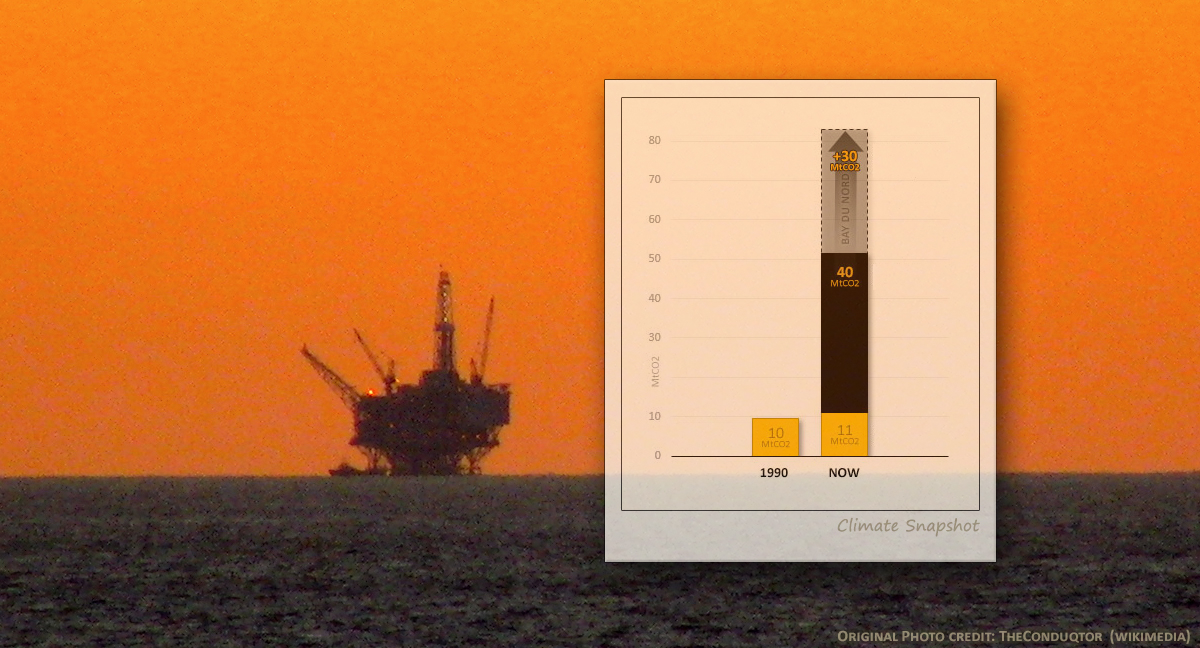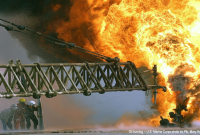Support strong Canadian climate journalism for 2025
The International Energy Agency has clearly stated that no new sources of fossil fuels can be developed if humanity wants to keep the climate crisis within the guardrails set in the global Paris Agreement. The oil industry in Canada, however, shows no sign it plans to do what's needed voluntarily.
The latest example is an industry proposal called Bay du Nord. It calls for developing a huge new complex of oilfields offshore of Newfoundland and Labrador. The industry plans to extract 200,000 barrels a day from this new complex. That much oil will add 30 million tonnes of CO2 (MtCO2) to our atmosphere every year when it is burned.

My chart puts it in context.
Back 1990 when Prime Minister Brian Mulroney first promised that Canada would reduce our climate pollution, Newfoundland and Labrador emitted 10 MtCO2. And they didn't have an oil extraction industry. Their climate impact back then is shown by the small bar on the left of the chart.
Since then, the province has increased emissions to 11 MtCO2. And oil extraction in the province has accelerated from zero to 95 million barrels a year. All that new oil is emitting 40 MtCO2 a year into the atmosphere when burned. The combined climate impact is shown in the tall bar on the chart.
Five times more CO2 is now flowing through Newfoundland and Labrador's economy than in 1990. And now the province and the oil industry are planning to toss another 30 MtCO2 a year on top if their push for the new Bay du Nord complex is approved.
There appear to be no functional brakes on our nation's runaway fossil-carbon juggernaut. Oil exports in Canada are record high and rising fast. We export six times more oil than we did in 1990. And the climate damage we are exporting in our oil has surged along with it — rising by half a billion tonnes of CO2 a year along the way.
Amazingly, half a billion tonnes of CO2 more since 1990 still isn't enough. To lock in even more, the current federal government has been pumping billions of dollars into a gigantic expansion of the TMX oil pipeline that terminates in our atmosphere.
Now that same federal government will soon decide whether to green-light sending a billion barrels or more from beneath Bay du Nord into our atmosphere as well.
*****
Endnotes:
- In Robert Louis Stevenson's famous novella, the kindly Dr. Jekyll had an out-of-control "Mr. Hyde" side of his personality. At one point, in his Mr. Hyde frenzy, he recklessly crashes into a child. Instead of stopping to care for the girl as he normally would, he "trampled over her body like some damned juggernaut." A fitting parable for our unrestrained fossil carbon extraction in Canada and how it threatens to trample our kids' future.
- Newfoundland and Labrador's in-province emissions increased 16 per cent since 1990 — from 9.5 MtCO2 in 1990 to 11.1 MtCO2 in 2019, which is the most recent data available (Canada's National Inventory Report).
- Oil production in Newfoundland and Labrador started in 1992 at four million barrels a year. In 2020, 104 million barrels were extracted. (CAPP data.)
- The Newfoundland and Labrador government plans to take a 10 per cent equity stake in the Bay du Nord project through a newly established Crown corporation, the Oil and Gas Corporation of Newfoundland and Labrador.
- The Bay du Nord proposal aims to start at 200,000 barrels a day. That adds up to a rate of 73 million barrels a year.
- The oil industry plans as many as 100 new exploratory wells in Newfoundland and Labrador's waters by 2028.
- Burning a barrel of oil results in ~430 kgCO2. (US EPA.)






Comments
I consider myself to be in the same choir as the author, and understand and agree, for example, with the UN's statement about the necessity to refrain from further fossil developments, but...
I am not a fan of (the relatively new inclusion in public discourse but, I suppose, longstanding notion of) Scope 3 emissions being attributed to the source of extraction. Thus, sentences such as: "That project, if built, will become Canada’s first deepwater oil site, emitting 30 million tonnes of carbon dioxide pollution annually.", in my opinion, don't move the conversation -- and action -- forward. At some point, it is necessary to assign some degree of responsibility to the addict and not blame only the pusher. We don't need to look far for that: Canadians, and certain regions of the national economy, for example, are as addicted as anyone, and more than most, to fossil fuels.
I have a great deal of empathy for the economic quandries of Newfoundland and Labrador, in particular, but also other regions of this country that have evolved to be nearly 100% reliant on resource extraction; "Hewers of wood and drawers of water" is a cliché that still applies, unfortunately, as soon as one sets foot outside our cities and the boardrooms, in those cities, of our plethora of resource companies.
If Canada is to ever grow up, we had better learn from history as to how to broaden our economy into the creation of real, novel goods -- preferably which don't destroy the ecosphere through their creation, use, and obsolescence -- rather than contenting ourselves with the status of mere waterboys and girls to the world's industrial economies: for as long as resources hold out; the 8 million other species of fellow travelers can eek out an existence in our company; and our land-base is able to absorb the waste products of this bottom-feeding economy.
Go ahead, ask me what I really think! :)